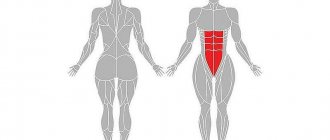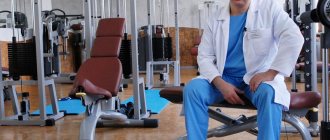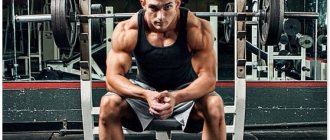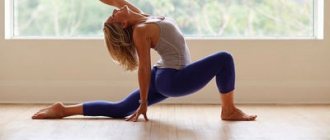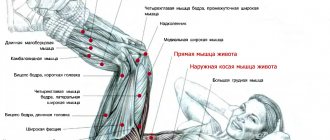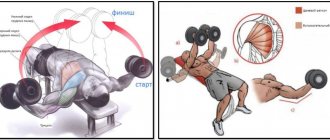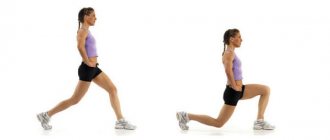Home ▸ Articles ▸ Workouts ▸ Training with ropes for CrossFit
Battle Ropes training has been a pretty hot topic in the fitness world for the past few years. This unique exercise tool has attracted many fans, and today such ropes can be seen everywhere from Adidas advertisements to UFC videos. They are considered to be best used in CrossFit.
In this article, you will learn both the basic principles and the latest CrossFit rope training techniques that have been used for the past few years.
Are there any contraindications?
Before considering the types and techniques of exercises with a rope, it is worth paying attention to what it involves - and therefore, what contraindications may arise when working with a rope. Since the rope implies a high static load on the back, then:
- you cannot work with a rope if you have problems with the spine;
- with an underdeveloped back muscle corset;
- with insufficiently developed muscles for dynamic loads;
- with injury to the lumbar region;
- in the presence of intervertebral hernias or sprains;
- in the postoperative period;
- with underdeveloped forearms;
- for problems in the abdominal area.
And most importantly, exercises with a rope are prohibited for people with problems with the cardiovascular system. Why? This is due to the fact that it is impossible to regulate the load by the number of times when working with a dynamic process, which means there is a risk of reaching and maintaining the pulse at peak load
Note: on the other hand, people with a high degree of fitness do not have to worry, since with a good vascular system, the pulse will reach the intensity of fat burning. This means that the entire rope complex is good to use for weight loss, without injuring muscles.
Why rope?
Why, in CrossFit, and in other speed-strength sports, exercises with ropes for the arms are increasingly gaining popularity. There are several explanations for this.
- Firstly, dynamic load. When performing classic exercises with a barbell or dumbbells, the arms work in a dynamic phase. That is, they rest and load up. When working with a rope, a micro-superset effect occurs. When exercises with a rope work in one phase of the movement, for example, the biceps, and in another - the triceps. This does not allow the muscles to rest, and supercompensation with stabilization increases isometric muscle performance, due to which athletes greatly increase strength endurance.
- The next point is the presence of isometry in the loads. When working with a rope, the muscles are worked at a very unusual angle, which allows you to engage the deepest muscle fibers without any problems.
- Thirdly, there is a low chance of injury. The main load is regulated by the speed of the exercise, and the maximum complexity is provided not by weight, but by the weakest component of the muscle corset, the wrists. And since the wrists cannot be stronger than the back muscles, it is simply impossible to accelerate the rope more strongly, because in case of critical load it will simply fly out of your hands.
Note: the rope flying out of your hands is fraught with stretching due to sudden movement and the resulting inertia.
Benefits of rope training
- Later formation of lactic acid in the upper body, which comes from long-term intense training with ropes. Accordingly, the intensity can be maintained for up to 5 minutes, and this is unique.
- Ropes fans are fun. Many people hate the gym, and not because they are lazy. It's just boring in a big typical gym and not much has changed in the last 30 years. And the ropes in training are like a breath of fresh air, invigorating and making you return to this “game” again and again.
- Development of mental endurance. When people start rope training, maintaining intensity for 1 minute seems like a pipe dream, but consistent training helps them overcome mental barriers, reach that goal, and gain new perspective and confidence.
- Finding balance. If you carefully observe the movements during rope exercises, you may notice that one side of your body may move differently than the other. This gives rise to a feeling of uncoordination. However, with continued training, these differences disappear. Gradually you will notice that your right and left sides begin to balance.
Exercises
What rope exercises are there?
- alternating waves in a half-squat;
- double wave;
- jumping with powerful claps;
- rotation from side to side;
- standing rope release;
- jumping with alternating waves;
- running in place;
- throwing yourself while sitting;
- plank with wave;
- side plank with rope.
Let's take a closer look at which muscle groups are involved in this or that exercise with a rope.
| Exercise | Muscle group | |
| Double wave | Upper shoulder girdle | |
| Jumping with powerful claps | Leg and abdominal muscles | |
| Rotation from side to side | Lateral abdominal muscles. | |
| Standing rope throw | Upper shoulder girdle | |
| Jumping with alternating waves | Leg muscles | Run |
| on the spot | Legs + heart | |
| Throws while sitting | Legs + body and core | |
| Plank with wave | Core+ press | |
| Side plank with rope | Core+ press | |
| Alternating waves in a half-squat | Upper shoulder girdle |
How are rope exercises performed?
As mentioned above, there are many ways to perform rope exercises. Therefore, each person will be able to choose suitable exercises for CrossFit.
The double wave exercise with weights allows you to pump up the muscle tissue of your shoulders and abs. It is done as follows:
- You need to take two ropes (it is advisable to take them wider so that it is impossible to close your hands completely). Then you need to bend your knees a little (sit down) and bend in the lumbar area. Your arms should be extended forward, but they should not be completely extended.
- Then you need to slowly start moving your hands up and down, and gradually increase the speed. Your hands should be squeezed tightly to prevent the ropes from jumping out.
- At the end of the rope, you need to make a sharp jerk with your hands to compensate for the inertia.
In order to alternate waves, you need to take the same starting position as in the previous one. But only here you need to wave your hands in discord: left - up, right - down, or vice versa. At the end you also need to make a sharp jerk.
Clapping jumps require some skill, so beginners cannot cope with them. Jumping with weights pumps up the muscles of the legs and back well. The starting position is the same as described above. After the ropes begin to vibrate, you must jump sharply; during the jump, you must try to raise your arms as high as possible. When landing, you need to lower your hands very quickly. At first, the ropes may fly out of your hands.
Rotation is one of the simplest varieties of this activity, but at the same time very effective. The starting position is assumed, and then you must first slowly and then quickly pull the ropes to the body, while the body must be turned in the direction of movement.
Everyone has heard about the benefits of planking; it allows you to pump up all muscle groups. The side plank with rope is only suitable for those people who know how to do a plank correctly. To complete it you will need:
- Take a side plank, you need to make sure that the main pressure is on the elbow. You must remember to keep your bend.
- In this position, you need to take the end of the rope with one hand.
- And then begin to move your body back, pulling the rope behind you. In this case, the strength should come not from the hands, but from the back and torso.
- Then you need to turn on the other side.
It is not necessary to include all of these exercises in the training program. You can choose more suitable ones, or alternate them to pump up your whole body. The main thing is to monitor your technique, so at first you should do everything at low speed. After the technique has been mastered, you need to gradually increase the speed.
How to do?
Despite its apparent simplicity, many rope exercises in the gym require special technique. The general principles for all exercises are the same:
- Do not use safety straps. The load should be limited to maximum wrist strength.
- Work at a moderate speed, increasing the load gradually as muscle mass increases.
- Combine with statodynamic exercises.
- Use basic pre-fatigue exercises before working with a rope.
- Work in pairs with a partner who will control the correct technique of performing the exercises.
- Use a heart rate monitor throughout your rope set. If your heart rate exceeds the permissible rate, stop and take a break.
Note: the maximum allowable heart rate is calculated using a simple formula (220-age) * 80%. Upon reaching this pulse, you need to immediately reduce the intensity of the exercise, since the athlete runs the risk of getting microtraumas to the heart, which will be overgrown with connective tissue, and thereby lead to sports heart disease.
Alternating waves in a half-squat
- Take two ropes of extremely large thickness (so that it is impossible to close your fingers around the diameter).
- Get into a half squat.
- Bend your lower back.
- Stretch your arms in front of you, not fully extending them at the elbow joint.
- Slowly start moving your right hand up and your left hand down.
- Gradually speed up your movements.
- At the end of the rope, make a sharp jerk to compensate for inertia.
Work until there is a strong pump or until the pulse reaches a critical level.
Double wave
This is a complicated version of the previous exercise, which requires more concentration, loads not only the upper shoulder girdle, but also the abdominal muscles, due to the need to dampen the inertia of the rope.
- Take two ropes of extremely large thickness (so that it is impossible to close your fingers around the diameter).
- Get into a half squat.
- Bend your lower back.
- Stretch your arms in front of you, not fully extending them at the elbow joint.
- Slowly start moving your hands down and then up.
- Gradually speed up your movements.
- At the end of the rope, make a sharp jerk to compensate for inertia.
Jumping with powerful claps
This exercise is somewhat more complicated, but it uses the leg muscles to their full potential, which can even replace a squat with a barbell.
- Take the ropes in your hands.
- Get into a half squat.
- Bend your lower back.
- Stretch your arms in front of you, not fully extending them at the elbow joint.
- After this, jump sharply up.
- At the same time, raise the ropes as high as possible above your head.
- At the moment of peak inertia, which coincides with the landing, make a “whip” movement, sharply lowering the ropes down.
If the ropes do not fly out of your hands, you can repeat. Work until the pulse is felt, or until the wrist muscles are severely weakened.
Rotation from side to side
- Take two ropes in your hands.
- Make a slight bend in the lower back, while keeping your back generally relaxed.
- Relaxing your lower back, begin to pull the ropes towards your belt (with an intense movement), while simultaneously turning your body in the direction of movement.
- At the peak of the load, turn in the other direction to achieve optimal results.
Repeat until completely exhausted.
Standing rope throw
The technique of a standing rope throw resembles a double wave. The main difference lies solely in the working amplitude. Instead of working in a half-squat, you need to work with a jump, while throwing the rope forward as much as possible (by moving your arms up). Otherwise, everything is identical.
Jumping with alternating waves
Variable wave jumps are performed as follows:
- Two ropes are taken;
- The starting position is taken from a full squat;
- Gradually, the movement begins with one hand down, the other up;
- Subsequently, a deep squat jump is performed;
- In this case, the wave movements do not stop, but only accelerate.
The ideal option is when there are no more than two cycles of wave movements of the arms per jump. The abdominal muscles, muscles of the upper shoulder girdle, back, pectoral and deltoids are worked out.
Granite Games Championship complexes
The Granite Games also began with a 1600-meter run, although not at the stadium, but over rough terrain. After this, one of the tournament favorites, Alessandra Piccielli (Italian national champion), was forced to withdraw from the competition due to an exacerbation of a foot injury received 2 weeks before the events.
The eighth complex turned out to be the most difficult for the participants. Only five men and two women managed to complete 3 rounds in 11 minutes with 30/22 calories on an exercise bike and 20 calf raises to the bar, and then do 60 barbell overhead raises.
| Complexes | Men | Women |
| Complex 1 – Cross 1600 meters | 1. Brendan Willis 33:13 2. Luke Schafer 33:56 3. Landon Walker 34:01 | 1. Carrie Beamer 35:34 2. Emily Rolfe 37:26 3. Jadzia Truszkowski 39:48 |
| Complex 2 – 400m Hill Sprint | 1. Travis Mayer 1:59 2. Josh Gervais 2:03 3. Ben Stoneberg 2:04 | 1. Kendall Vincelette 2:27 2. Carrie Beamer 2:32 3. Sarah Viets 2:38 |
| Complex 3 Power ladder of 5 lifts: - Women: 70-72.5-75-77-79/ 80-83-85-88-90/ 93-95-97.5-100-102 kg - Men: 110- 115-120-122-125/ 127-130-135-138-140 /143-147-150-154-156 kg Time to complete: 1-2-3 minutes | 1. Paul Tremblay 2. Nick Bloch 3. Travis Mayer | 1. Winter Rodriguez 2. Ehea Schuerch 3. Taylor Williamson |
| Complex 4 Perform in time (Limit - 10 minutes): - 50 pull-ups to the chest - 40 rows with dumbbells - 30 squats with dumbbells overhead - 20 overhead dumbbell raises - lunges with dumbbells overhead to the finish Weight of dumbbells: 25/15 kg | 1. Justin Medeiros 3:39 2. Josh Gervais 3:50 3. Spencer Panchik 3:56 | 1. Elizabeth Wishart 4:28 2. Taylor Williamson 4:33 3. Andrea Nisler 4:39 |
| Complex 5 Perform for a time (limit - 16 minutes): - 18 m sled push 102/79 kg - 18 m farmer's walk with dumbbells 32/22.5 kg - 18 m hand walk back - 18 m farmer's walk 32/22, 5 kg - 18 m sled push 102/79 kg - 18 m hand walk back Then, repeat 1 more lap. | 1. Brent Fikowski 8:54 2. Saxon Panchik 9:10 3. Justin Medeiros 9:12 | 1. Emily Rolfe 9:56 2. Carrie Beamer 10:34 3. Andrea Nisler 10:52 |
| Complex 6 4 laps (cover - 14 minutes): - 8 power-ups on the bar - 40 doubles through the rope - 12 snatches 52/34 kg | 1. Justin Medeiros 8:01 2. Saxon Panchik 8:16 3. Josh Gervais 8:22 | 1. Kendall Vincelette 9:22 2. MaryKay Dreisilker 9:43 3. Carrie Beamer 9:52 |
| Complex 7 Perform in time (limit - 9 minutes): - 18 m sandbag carry - 40 squats with a sandbag 36 m sandbag carry - 30 strict handstand push-ups - 36 m sandbag carry - 40 squats with a sandbag - 18 m sandbag carry Weight sandbag: 68/45 kg | 1. Colten Mertens 5:55 2. Brendan Willis 6:37 3. George Sterner 6:48 | 1. Andrea Nisler 4:58 2. Jadzia Truszkowski 5:07 3. Emily Rolfe 5:42 |
| Complex 8 Do 3 laps for time (limit - 11 minutes): - 30/22 cal bike - 20 leg raises to the bar Then, - 60 overhead lifts of the barbell with Axel bar Weight on the bar: 68/45 kg | 1. Nick Bloch 6:46 2. Brent Fikowski 10:35 3. Cole Greashaber 10:45 | 1. Emily Rolfe 10:48 2. Sarah Viets 10:58 3. Taylor Williamson CAP+56 |
| Complex 9 Perform as quickly as possible (cover - 10 minutes): - 4-3-2: rope climbs - 16-12-8 sandbag lifts 68/45 kg | 1. Brent Fikowski 4:41 2. Josh Woodhull 4:52 3. Travis Mayer 4:53 | 1. Taylor Williamson 5:10 2. Emily Rolfe 5:24 3. Carrie Beamer 5:25 |
Winners among men:
- Travis Mayer*(712)
- Brent Fikowski*(648)
- Nick Bloch (632)
- Justin Medeiros (622)
- Saxon Panchik*(618)
Women's results:
- Emily Rolfe (736)
- Carrie Beamer (708)
- Andrea Nisler (684)
- Taylor Williamson (656)
- Ehea Scherch*(630)
*athlete Games
Team standings leaders:
- CrossFit Krypton (1598)
- Invictus X (1558)
- RPM Central Beasts (1504)
- Alexis Jen Travis & Roy (1498)
- OPT Brutes (1424)
leaders of Granite Games.
Upper body and core exercise
These are the same exercises with a rope for classic crossfit, the emphasis in which is not on the hands at all, but on working with a partner and correct body movements.
Throws while sitting
The exercise is similar to working with turns. The main difference is the isolation of the abdominal and core muscles, which is achieved by turning off the muscles of the legs and lower back, which eat up the lion's share of the load.
- Sit on the floor;
- Take 2 ropes in your hands;
- Make wave movements, while trying to pull the ropes to the belt;
- At the moment of attraction, gradually turn the body;
- At the peak of the load from the rope, turn in the other direction.
Plank with wave
The wave plank is a rather pointless exercise in terms of difficulty/effectiveness, but many lovers of handstands in the prone position love it because it allows you to develop the core muscles, much more effectively than a vacuum.
How to do it correctly:
- Get into the plank position on one arm (the hand should rest not on the floor, but on a special stand);
- The second hand should hold the rope;
- Slowly begin to make a wave movement from side to side, gradually accelerating.
Work until the heart rate monitor reaches a critical point.
Side plank with rope
This is a very simple exercise for those who have mastered the side plank.
- Get into a side plank position with the main weight resting on your elbow;
- Maintain deflection;
- In the other hand, take the rope by the tip;
- And slowly - by turning your body back and moving your shoulder blades, move the rope towards you.
It is important to do this not with your arms (biceps muscles), but with your back and body.
- When you reach the end of the rope, turn to the other hand and continue the exercise.
The main feature is cyclicality, and high involvement of the rhomboid muscles of the back and oblique abdominal muscles. The movement occurs solely due to traction with the elbow (not the wrist), which allows you to completely disable the shoulders.
Rope climbing techniques
There are several types of rope climbing techniques. Let's look at each of them in detail:
Rope climbing in three steps
- Starting position: the athlete holds the rope tightly with his hands and feet (the toe of one foot and the heel of the other foot).
- Push off the rope with your legs, bend them and grab the rope a little higher in the same way.
- Without letting go of the rope with your feet, alternately move your hands higher and repeat the movement.
Rope climbing in two steps
There are two ways to climb a rope in two steps.
First way:
- Starting position: one hand is fully straightened and clasps the rope above head level, the other hand is held at chin level. We grab the rope with our feet with the toe of one foot and the heel of the other.
- We push off with our feet and try to pull ourselves up on the arm that is located higher.
- With the other hand we intercept the rope higher, at the same time we pull up our legs and take the starting position.
Second way:
- Starting position: hands are located at the same level just above the level of the head, one is located immediately below the other. We hold the rope with our feet in the same way - toe and heel.
- Push off with your legs, grab the rope a little higher, pull yourself up, intercept the rope and hang with straight arms.
Rope climbing without using legs
- Grasp the rope with both hands, one should be slightly higher than the other, bend your legs slightly or bring them out in front of you.
- Maintaining the position of your legs and body, rise up, alternately changing hands and using the latissimus dorsi and forearm muscles.
Jale Ibrak - stock.adobe.com
This video demonstrates various rope climbing techniques:
”alt=””>
If you have just recently started doing CrossFit and are not yet ready for rope climbing, start training with a lead-in exercise: pull yourself up the rope with your hands, starting the movement from a sitting position. The legs do not work, but only rest their heels on the floor. As soon as you have risen as high as possible and fully straightened your knees, begin to lower yourself down again, while the movements should be coordinated and monotonous, your palms should be removed at the same distance from each other. This will give you a good understanding of the biomechanics of movement and improve the strength of your hands and forearms.
In order to make this exercise easier for you, and to improve rope climbing, you need to separately perform the elements that make up this exercise
Pay special attention to grip strength: practice hanging on a rope, on a horizontal bar and on a towel suspended from a bar - this will strengthen your hands and forearms, and your own weight will not seem so heavy when climbing the rope
Learn to do one-arm pull-ups, this will make it much easier for you to learn how to climb a rope without legs. Do pull-ups and other latissimus dorsi exercises to build your strength.
Once you have mastered at least one method of rope climbing, make this process more extreme - try to climb the rope in the shortest possible time, without resting between approaches. This way you will increase strength endurance and the overall physical potential of your body, and more complex climbing options will be easy and relaxed.
Training video for beginners, summary exercises:
”alt=””>
Bottom line
As can be seen from all of the above, exercises with a rope can replace almost the entire gym equipment. After all, during work, both the muscles of the legs and abs, as well as the muscles of the back and upper shoulder girdle are involved. The ability to constantly increase the load without risking injury makes the exercises most effective for all groups of athletes, both beginners and experienced athletes.
And most importantly, eliminating inertia in most exercises allows you to work not only on strength and endurance, but also on explosive characteristics. It is due to the explosive elements that the muscles are worked as deeply as possible (after all, about 80% of the muscle fibers are involved), and with the correct load, exclusively lean muscle mass grows, with a high ability to recover. Therefore, rope exercises are highly recommended for those athletes who engage in impact sports. Working with a rope allows you to increase the impact force up to 7 times in 2 months of training.
